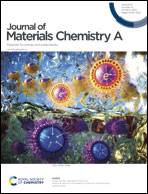Fabrication of a highly stable Nb2O5@C/CNTs based anolyte for lithium slurry flow batteries†
Abstract
Improving the stability of the anolyte and catholyte is crucial for the fabrication of high-performance lithium slurry flow batteries (LSFBs). To achieve an optimal slurry electrode for LSFBs, an anisotropic Nb2O5@C/CNTs nanocomposite was synthesized. The effects of active material content on the electrical and rheological behaviors of the slurry were studied systematically. An approximate bell-shaped curve depicts the variation trend of electronic conductivity under different Nb-based active material contents. The high aspect ratio of carbon nanotubes was found to be responsible for the formation of a conductive network in the slurry. The optimal matching point between active materials and KB increased from 8 wt% (Nb2O5@C) to 16 wt% (Nb2O5@C/CNTs). Under the condition that a KB percolation network was created, the as-prepared Nb2O5@C/CNTs anolyte delivers a high specific capacity of 217 mA h g−1 and Coulombic efficiency > 92% in the flow reactor under a static mode. Moreover, the assembled flow reactor could work well under an intermittent flow mode, which indicates the feasibility of the as-prepared anolytes in a flow reactor. The fabrication of the highly stable Nb2O5@C/CNTs based anolyte will be helpful for the development of high energy density LSFBs with ultralong cyclability.



 Please wait while we load your content...
Please wait while we load your content...